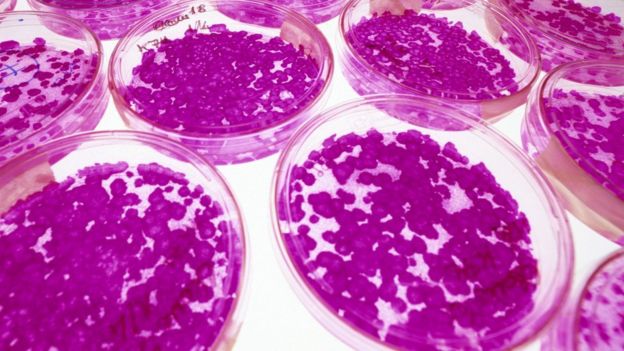幹細胞培植腎臟 初見成果
截至 2014 年年底,香港就有 1965 人等待腎臟移植,單靠活體或者屍腎移植根本不足以滿足龐大的需求。幹細胞器官培植就成為近年病人的希望。奈何研究仍然充滿阻滯。不過,最近 PNAS 期刊發佈的一項幹細胞器官培植研究或會為腎臟病人帶來一點曙光。
以往都有不同的幹細胞培植方法「製造」腎臟。一般做法是將後腎 (metanephroi) 從複製胚胎直接移植到動物身上。然而,這個方法總有兩個主要問題:尿液無法正常由腎臟排出(腎積水),以及有限的腎臟存活和發育機率。
以日本學者横尾隆為首的研究團隊為了解決這個問題,他們利用幹細胞培植腎臟、排尿管和膀胱,然後將它們接駁到老鼠的原有膀胱,試圖解決排尿問題。他們檢查後發現,這個以名為 Stepwise Peristaltic Ureter System 的技術成功將尿液從新的腎臟經膀胱流至原生膀胱。而且在八周後,新腎臟的功能仍然正常發育和運作。有見及此,他們繼而利用同樣的方法應用在豬身上,也得出同樣成果。
雖然進展良好,但技術要應用在人體上仍需要一段時間。他們在報告中指,未來會嘗試將以人類幹細胞培育的腎臟在豬身上測試,以了解幹細胞培植的人類器官能否在實際環境正常運作或者是否出現安全問題等。循這個方向發展,或有一天,我們不須再透過登記成為器官捐贈者去幫助腎病病人,成熟的腎臟移植技術將能舒緩活體或者屍腎不足的問題。
報告:
Shinya Yokotea, S., Matsunari, H., Iwaid, S. & et al. (2015). Urine excretion strategy for stem cell-generated embryonic kidneys. PNAS, published online before print September 21, 2015. DOI: 10.1073/pnas.1507803112
原文:
BBC, Lab-grown kidneys work in animals, 22 September 2015
Lab-grown kidneys work in animals
- 22 September 2015
- Health
 Science Photo Library
Science Photo Library
Scientists say they are a step closer to growing fully functioning replacement kidneys, after promising results in animals.
When transplanted into pigs and rats, the kidneys worked, passing urine just like natural ones.
Getting the urine out has been a problem for earlier prototypes, causing them to balloon under the pressure.
The Japanese team got round this by growing extra plumbing for the kidney to stop the backlog, PNAS reports.
Although still years off human trials, the research helps guide the way towards the end goal of making organs for people, say experts.
In the UK, more than 6,000 people are waiting for a kidney - but because of a shortage of donors, fewer than 3,000 transplants are carried out each year.
More than 350 people die a year, almost one a day, waiting for a transplant.
Growing new kidneys using human stem cells could solve this problem.
 SPL
SPL
Dr Takashi Yokoo and colleagues at the Jikei University School of Medicine in Tokyo used a stem cell method, but instead of just growing a kidney for the host animal, they set about growing a drainage tube too, along with a bladder to collect and store the urine.
They used rats as the incubators for the growing embryonic tissue.
When they connected up the new kidney and its plumbing to the animal's existing bladder, the system worked.
Urine passed from the transplanted kidney into the transplanted bladder and then into the rat bladder.
And the transplant was still working well when they checked again eight weeks later.
They then repeated the procedure on a much larger mammal - a pig - and achieved the same results.
Prof Chris Mason, an expert in stem cells and regenerative medicine at University College London, said: "This is an interesting step forward. The science looks strong and they have good data in animals.
"But that's not to say this will work in humans. We are still years off that. It's very much mechanistic. It moves us closer to understanding how the plumbing might work.
"At least with kidneys, we can dialyse patients for a while so there would be time to grow kidneys if that becomes possible."
Other scientists have looked at rejuvenating old organs that would not normally be suitable for transplanting. Prof Harald Ott and colleagues have been testing out a method that washes away the tissue from dead organs to leave a scaffold that can be repopulated with healthy new cells.
Prof Ott says using a scaffold is a good short cut, rather than having to grow whole structures from scratch.

tin tuc suc khoe
回覆刪除suc khoe gioi tinh
suc khoe va lam dep